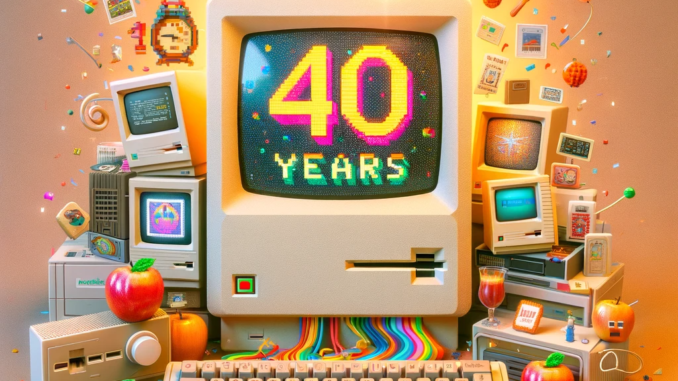
by Larry Magid
This post first appeared in the Mercury News
Wednesday marked the 40th anniversary of the Apple Macintosh. It came out about a year into my tenure as a syndicated tech columnist, and even back then, I had seen a lot of new personal computers. But when Steve Jobs showed it to me weeks before the announcement, I was blown away.
My column, which ran in the Jan. 29, 1984, edition of the Los Angeles Times and other papers, started with the words, “I rarely get excited over a new computer. But Apple’s Macintosh, officially introduced last Tuesday, has started a fever in Silicon Valley that’s hard not to catch.” I added, “By the time I got my hands on the little computer and its omni-present mouse, I was hooked. Apple has a winner.”
That original Mac, which cost $2,495 ($7,510 in today’s dollars) was about 14 inches tall and took up about the same amount of desk space as a piece of 8½ x 11 paper. Long before there were laptops, it was “smaller and lighter than most of the so-called ‘portable’ machines. The entire system can be slipped into an optional ($99) padded carrying case to be hoisted over your shoulder or placed under an airline seat.”
What impressed me most was its graphical user interface, not unlike what we still have on today’s Mac and Windows PCs. The new Mac came with “two valuable programs, MacPaint and MacWrite free with the machine,” as I wrote in that original review. I was impressed that it let you “vary the size and style of your type on the screen and on paper, when used with Apple’s new $495 Image Writer printer,” resulting in the first truly “what you see is what you get” word processing system on a moderately priced microcomputer. I called it “magic,” because it really did seem like magic at the time.
Saved money on graphics and typesetting
In addition to being a computer columnist, I was co-founder and vice president of a small company that taught corporate clients how to use IBM PCs and software like VisiCalc, dBase II, Lotus 1-2-3 and WordStar. I was one of the first to buy an IBM PC (I wrote one of its manuals and was an early editor of PC Magazine) and my company owned more than a dozen IBM PCs. But, as soon as I could buy one of those new Macs, I got one for the company that we used to create graphic-rich training materials, saving us a great deal of money on typesetting and artwork, especially after Apple released its first laser printer in 1985.
Using an early Mac felt like both an upgrade and a downgrade from the IBM PC on my desk at home, which I had upgraded with a 10-megabyte hard drive, lots of memory and plenty of software, compared with that little Mac with its 128K of Random Access Memory (RAM), 64K of Read Only Memory (ROM) and one 400K disk drive. When it came to performance, memory, storage and available software, it was a big step backward, but when it came to productivity and the sheer joy of using a whimsical and fun new machine, it was a big upgrade.
Competing with IBM
Before the Mac came out, Apple’s main product was the Apple II, which had given up a great deal of market share to the IBM PC. As I wrote in my review, “Apple’s young Chairman, Steve Jobs blames his company’s relatively poor performance on trying to compete with IBM on its own terms rather than ‘getting back to our roots.'” He told me that Apple would focus its marketing efforts on small businesses, home users, and colleges rather than Fortune 500 companies. Although Apple’s initial Mac sales paled compared with those of IBM at the time, Apple is still in the personal computer business. IBM, which had to compete with dozens of “clones” that worked exactly like its PC, eventually stopped making PCs after its market share fell below that of some of its competitors. Unlike Apple, which wrote its own operating system for the Mac, IBM relied on Microsoft’s PC-DOS operating system, which Microsoft was able to license to other companies under the name MS-DOS. To this day, if you want to buy a machine that runs any Apple operating system, you have to buy it from Apple.
Evolution of Apple
The Mac is still far from the most popular PC, though it is growing in popularity with 30.6% market share in 2023, according to Statista. But even though Windows machines collectively outsell the Mac, Apple has been able to cash in big-time with its other products, including the iPhone, which has helped turn Apple into a $3 trillion company, the biggest company in the world in terms of market capitalization. In 2007, Apple dropped “computer” from its name and is now a major player not just in phones, PCs and other devices but also in music, video streaming and even original movies and TV shows. Apple is about to enter the world of extended reality with its Apple Vision Pro, available Feb. 2, for $3,495. That’s a lot of money for a headset, but adjusted for inflation, it’s just a little over half the cost of the original Mac.
Whether you own a Mac, a Windows PC, an iPhone or an Android, you owe some gratitude to “Apple’s young chairman,” Steve Jobs (1955-2011), who had the vision and the guts to bet his company and his career on unproven products that helped change the world.
Larry Magid is a tech journalist and internet safety activist. Contact him at larry@larrymagid.com.